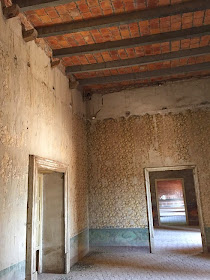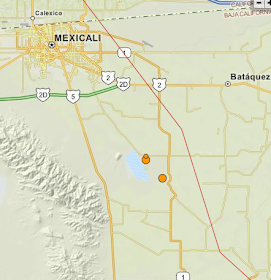Jonathon Sturgeon reviews
Signs Preceding the End of the World, in Flavorwire
What will we make of North American civilization, in the broad, continental sense, when it is gone? When its states have vanished or dissolved or slowly mutated into other states, how will we remember the borders that once existed between them? Or, for example: how will the war of attrition waged by the U.S. along the border of Mexico be understood in two or three centuries?
These are questions we could leave to congressman, television pundits, gun-toting ranchers, historians, whoever: there is no shortage of American conservatives who have made their reputations and livelihoods off borderland speculation and its attendant scaremongering. But, though we rarely do it, we could also turn to artists and novelists to understand how the state between states projects us into the future. Why shouldn’t we? The territory between the U.S. and Mexico is as much a zone of language as it is a disputed territory. And the novel, especially the poetic novel, is the best place we can turn to watch language morph between states.
In the hands of Yuri Herrera, who has been called Mexico’s greatest living novelist, the border between Mexico and the United States becomes an event horizon. Or at least in Signs Preceding the End of the World, his first and only novel to be translated into English — deftly, by Lisa Dillman — the perilous journey across the geographically and politically fraught borderland is as much about crossing a threshold of time and being as it is entering a dangerous new country. In Herrera’s novel, as in Andrei Tarkovsky’s Nostalghia, nation states are equivalent to states of being. Reading Signs Preceding the End of the World is like watching a living thing violently yet breathtakingly metamorphose in front of your eyes.
The novel begins, ends, and is carried through entirely on the shoulders of the Atlas-like Makina, a character, a young woman, who will be read, discussed, and emulated for decades to come. Wise but curious, tough but necessitous, resilient but not impervious to suicidal thoughts, Makina is tasked with delivering a note to her brother, who has foolishly absconded to the U.S. after he is tricked into believing there is land for him there. When we first meet her, she narrowly misses being swallowed into a sinkhole. When we leave her, she has been swallowed into a new existence.
Along the way, Makina meets a procession of figures, a dozen Virgils — crime lords, a coyote named Chucho, even a corpse — who usher her almost ceremoniously toward the border. And the nearer she is to the border, the more intensified the violence, literal and poetic, becomes. This accounts, too, for the novel’s noirish, hybridized prose and its strange-but-spare poetic interpolations, such as when Makina “verses” instead of exits or leaves a place. Not only does it feel as if she is transversing a terrain; it also implies, in the sense of Jean-Paul Sartre, that the novel contains no exit.
Given that they exist on a threshold, Herrera depicts the people on the border, toward whom Makina is naturally inclined, as transitional — not only between states, but between past, present, and future:
They are homegrown and they are anglo and both things with rabid intensity; with restrained fervor they can be the meekest and at the same time the most querulous of citizens, albeit grumbling under their breath. Their gestures and tastes reveal both ancient memory and the wonderment of new people. And they they speak. They speak an intermediary tongue that Makina instantly warms to because it’s like her: malleable, erasable, permeable; a hinge pivoting between two like but distant souls, and then two more, and then two more, never exactly the same ones; something that serves as a link.
On the other side, in the United States, things are appropriately alien. (That is also to say: pompously Roman.) I can think of no recent novel, in fact, that alienates the U.S. so convincingly, as in the case of this explanation of baseball as military simulation:
Every week the anglos play a game to celebrate who they are. He stopped, raise his cane and fanned the air. One of them whacks it, then sets off like it was a trip around the world, to every one of the bases out there, you know the anglos have bases all over the world, right? Well the one who whacked it runs from one to the next while the others keep taking swings to distract their enemies, and if he doesn’t get caught he makes it home and his people welcome him with open arms and cheering.
At little more than a hundred pages, Signs Preceding the End of the World has been called an odyssey, but I don’t buy it — its protagonist is not homeward bound. Either way, what Makina finds of her brother, of herself, on the other side of the event horizon, in the infinitely dense black hole called the United States, is a tragically common occurrence. But as Yuri Herrera proves: it has to be read to be believed.
 Mexico calling has been a labor of love. It has gotten more attention from me the closer Bev and I were to moving to San Miguel. That decision was long in coming, the move to Mexico. We spent all of February in San Miguel, flew back to Portland, loaded a lot of stuff in the Clampett mobile (seen left fully loaded) and drove back down to San Miguel - 3,300 miles, arriving on March 29th. Tomorrow marks a whole month at Casa Sundance. I have never been happier.
Mexico calling has been a labor of love. It has gotten more attention from me the closer Bev and I were to moving to San Miguel. That decision was long in coming, the move to Mexico. We spent all of February in San Miguel, flew back to Portland, loaded a lot of stuff in the Clampett mobile (seen left fully loaded) and drove back down to San Miguel - 3,300 miles, arriving on March 29th. Tomorrow marks a whole month at Casa Sundance. I have never been happier.
















.jpg)



















.jpg)



.jpg)





